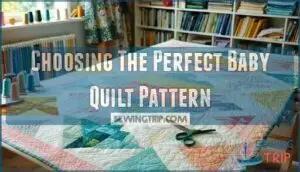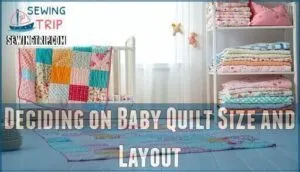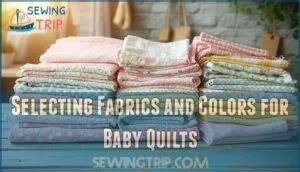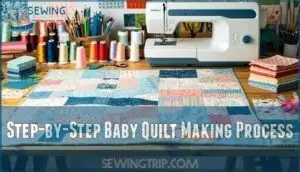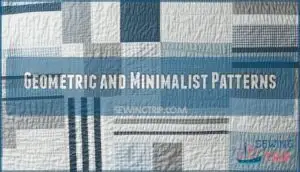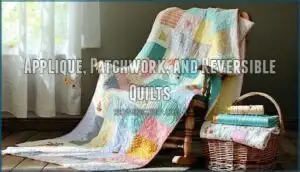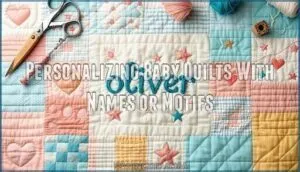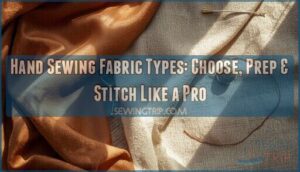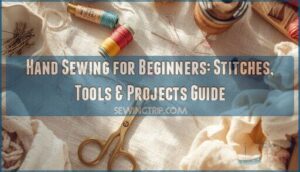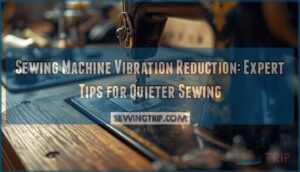This site is supported by our readers. We may earn a commission, at no cost to you, if you purchase through links.
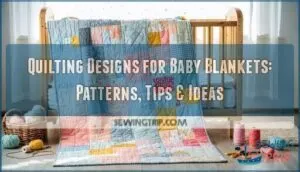
Quilting designs for baby blankets range from dead-simple squares you can finish in a weekend to intricate patterns that become family heirlooms. The best design isn’t always the fanciest one. It’s the one that matches your skill level, fits your timeline, and uses fabrics safe enough for sensitive skin.
Whether you’re stitching your first quilt or your fiftieth, choosing the right pattern makes all the difference between a project you’ll finish and one that lives in your closet for years.
Table Of Contents
- Key Takeaways
- Essential Supplies for Baby Quilt Making
- Choosing The Perfect Baby Quilt Pattern
- Deciding on Baby Quilt Size and Layout
- Selecting Fabrics and Colors for Baby Quilts
- Step-by-Step Baby Quilt Making Process
- Creative Ideas and Trends in Baby Quilt Designs
- Frequently Asked Questions (FAQs)
- Conclusion
Key Takeaways
- Baby quilts don’t need perfect technique—simple patterns using large squares, strips, or precut fabrics work beautifully for beginners and create cozy, functional blankets babies will love.
- Choose quilting cotton or organic fabrics for safety and washability, prewash to prevent shrinkage, and use low-loft batting to keep quilts lightweight and easy to clean through countless wash cycles.
- Standard baby quilt sizes range from 30×35 inches for strollers to 36×52 inches for cribs, but the right dimensions depend on how you’ll use the quilt—whether for cuddles, playtime, or as a keepsake.
- Personalizing quilts with names, applique motifs, or trending designs like woodland animals transforms a handmade blanket into a treasured heirloom that grows in meaning over the years.
Essential Supplies for Baby Quilt Making
Before you pick up a needle, you’ll want to gather the right supplies. Quality tools make the process smoother and help you create a quilt that’s both beautiful and safe for baby.
Here’s what you need to get started.
Must-Have Quilting Tools for Beginners
You don’t need a garage full of fancy gadgets to start quilting—just a few reliable tools will set you up for success. Grab a rotary cutter and mat for clean cuts, a quilting ruler for accuracy, and a seam ripper for quick fixes.
Your sewing machine, an iron, and marking tools round out your essential quilting supplies, giving you everything needed to create a beautiful baby quilt.
Choosing Quality Fabric and Batting
Once you’ve got your tools lined up, the fabric and batting you choose will make or break your quilt’s softness, durability, and washability.
Here’s what to prioritize when selecting quilting supplies:
- Quilting cotton — Tightly woven, breathable, and machine washable, it’s the ideal choice for baby quilts
- Low-loft batting — Provides gentle warmth without bulk, making the quilt easier to quilt and wash
- Organic options — Safe for sensitive skin and free from harsh chemicals
Pre-washing fabrics prevents shrinkage later, and checking fabric weight guarantees your quilt stays cozy without being heavy.
Precut Fabrics Vs. Yardage: Pros and Cons
When it’s time to grab fabric, you’ll face a choice: precut bundles like fat quarters and jelly rolls, or traditional yardage cut fresh off the bolt. Here’s how they stack up:
| Factor | Precut Fabrics | Yardage |
|---|---|---|
| Time Efficiency | Ready to sew—no cutting | Requires measuring and cutting |
| Cost Comparison | Higher per square inch | More economical for large quilts |
| Fabric Variety | Coordinated prints included | You pick every print yourself |
Precuts save time and reduce fabric scraps, making them perfect for beginner projects.
Yardage offers better waste reduction and project suitability when you need specific dimensions or prefer complete creative control.
Choosing The Perfect Baby Quilt Pattern
Picking the right pattern can feel like choosing between a hundred adorable baby outfits—exciting but a little overwhelming. The good news is that you don’t need complex skills to create something beautiful and functional.
Let’s look at beginner-friendly options, style considerations, and where to find patterns that won’t cost you a dime.
Easiest Baby Quilt Patterns for Beginners
Starting with a simple patchwork square or a bold strip quilt can feel like learning to ride a bike with training wheels—you’ll build confidence fast without getting tangled in complicated piecing.
Try these beginner quilting projects:
- Simple Squares using large blocks you arrange like a checkerboard
- Strip Quilts sewn with straight seams—no matching corners required
- Charm Packs with precut 5-inch squares ready to sew
- Precut Panels featuring illustrations you surround with coordinating fabric borders
Many free baby quilt patterns use these easy baby quilt patterns to help you finish quickly.
Modern Vs. Classic Quilt Designs
Choosing between modern geometric patterns and traditional patchwork comes down to whether you’re drawn to clean lines or cozy nostalgia—and both styles work beautifully for baby quilts.
Modern baby quilt designs lean toward minimalist shapes and bold color palettes, while classic patterns embrace scrappy prints and time-honored blocks.
Your fabric choices and quilting styles shift the whole feel—geometric baby quilt patterns pop with solids, but easy baby quilt patterns using florals bring warmth and charm.
Where to Find Free Baby Quilt Patterns
You’ll discover thousands of free baby quilt patterns across trusted websites like The Polka Dot Chair, Fat Quarter Shop, and Diary of a Quilter—each offering beginner patterns with step-by-step photo tutorials you can download instantly.
These sites feature everything from simple patchwork to modern geometric baby quilt designs, plus community features where quilters share finished projects and tips that make learning easier.
Many resources offer free baby quilt patterns online.
Deciding on Baby Quilt Size and Layout
Before you cut your first piece of fabric, you’ll want to nail down the size of your quilt. The right dimensions depend on how you plan to use it—whether it’s draped over a crib rail, tucked into a stroller, or spread out on the floor for tummy time.
Let’s look at the standard sizes and how to adjust patterns to fit your vision.
Standard Baby Quilt Dimensions
Most baby quilts fall somewhere between 30 and 45 inches square, but knowing the exact dimensions you need can save you from making a blanket that’s too small for snuggles or too bulky to toss in the diaper bag.
A standard crib quilt usually measures 36 by 52 inches, while receiving blankets run smaller at around 30 by 40 inches. Toddler quilts stretch bigger—roughly 40 by 60 inches—giving growing kids more room to wrap up.
Crib, Stroller, and Playmat Quilt Sizes
If you’re stitching a quilt that’ll live in the crib, ride along in the stroller, or cushion tummy time on the floor, nailing the right size makes all the difference between a blanket that works and one that just takes up space.
A crib quilt generally sits at 36 by 52 inches, while stroller quilt dimensions run smaller—around 30 by 35 inches—so it won’t drag on the ground.
Playmat quilt projects work best at 40 by 40 inches or larger, giving babies room to roll and explore safely.
Tips for Scaling Quilt Patterns
Tweaking a pattern to fit your vision is like adjusting a recipe—you don’t need to follow it word for word to end up with something delicious. Start by adding or removing blocks in the pattern repeat to change dimensions. Border adjustments give you quick inches without messing with block proportion.
Keep fabric consumption in mind—bigger quilts eat more yardage fast. Resizing challenges pop up when blocks don’t divide evenly, but simple math smooths that out.
Selecting Fabrics and Colors for Baby Quilts
Picking the right fabric and colors isn’t just about looks—it’s about keeping baby safe, comfortable, and happy. You’ll want materials that are soft against delicate skin, easy to toss in the wash, and durable enough to survive countless cuddles.
Here’s what you need to know about choosing fabrics, coordinating colors, and making smart choices that balance beauty with practicality.
Best Fabrics for Baby Blankets
Your fabric selection can make or break a baby quilt’s safety and comfort. Organic cotton leads the pack—95% certified organic content meets Global Organic Textile Standard requirements, grown without pesticides or GMOs.
For softness factors, bamboo fabric stays naturally 3°C cooler while wicking moisture away from delicate skin. Bamboo is also known for its natural antibacterial properties, making it a great choice for baby products.
When choosing baby quilt fabrics, consider flannel baby quilt options for extra coziness, though merino wool offers enhanced breathability without overheating risks. Prioritize washability concerns by selecting fabrics that survive frequent laundering. Smart fabric combinations balance durability needs with gentle textures babies deserve.
Color Combinations and Print Ideas
Once you’ve settled on that super-soft fabric, the real fun begins—picking out colors and prints that will turn your quilt into a keepsake. Think about your color palette first—will you go bold with high color contrast or stick with gentle pastels? Gender neutrals like sage green and warm gray remain popular, while seasonal colors add timeless charm.
- Modern geometric fabric prints paired with solid color schemes create striking visual interest
- Woodland animal themes work beautifully with earthy fabric combinations
- Rainbow color palettes bring playful energy when balanced with neutral backing
- Monochromatic fabric combo ideas using different print scales add elegant depth
Safe and Washable Fabric Choices
Looking at all those gorgeous colors and prints you’ve chosen, you’ll want to make sure every yard of fabric is actually safe for baby’s delicate skin and can withstand countless trips through the washing machine. Stick with natural fibers like quilting cotton—they’re breathable and gentle.
Prewashing fabrics removes excess dye and shrinks them before you sew, preventing surprises later. Always choose washable materials that can stand up to spit-up and diaper blowouts without falling apart.
Step-by-Step Baby Quilt Making Process
Making a baby quilt doesn’t have to feel overwhelming if you break it down into clear steps. From cutting your first fabric pieces to adding that final binding, each part of the process builds on the last.
Here’s how to turn your chosen pattern and fabrics into a finished quilt you’ll be proud to give.
Cutting and Piecing Quilt Blocks
Precision matters most when you’re turning flat fabric into blocks that need to line up perfectly—because even a quarter-inch off now means wonky seams later. Use your rotary cutter against a clear ruler to slice straight edges along the fabric grain.
When piecing seams for your quilt blocks, match pattern edges carefully and press each half-square triangle or patchwork quilt piece flat before joining the next. Your quilt top depends on accurate cutting and consistent quarter-inch seams throughout block assembly.
Assembling The Quilt Sandwich
Now that your blocks sit crisp and flat, it’s time to layer everything together into what quilters call the quilt sandwich—batting nestled between your pieced top and backing fabric.
Start with backing fabric facing down, add your batting type (cotton or polyester both work), then place your quilt top face-up. Smooth out wrinkles as you go, keeping layering order consistent.
Pin or spray-baste through all three layers to prevent shifting before you start quilting.
Simple Quilting Techniques for Beginners
With your sandwich secured, you’re ready to stitch all three layers together—and the good news is, you don’t need fancy equipment or years of practice to make it beautiful.
Start with straight-line quilting—just follow seam lines or grid patterns. Try simple applique with fabric scraps for charm.
These beginner quilting projects work perfectly with easy baby quilt patterns, building your confidence without overwhelming you.
Binding and Finishing Touches
After all that careful stitching, binding transforms raw edges into a polished frame—and it’s easier than you think. Choose your binding methods and corner options first. Here’s a quick binding tutorial:
- Cut 2½-inch strips and join them
- Fold binding in half lengthwise
- Attach to quilt front, mitering corners
- Hand-stitch to back
Add label placement with washing instructions, then consider edge embellishments for extra charm on your baby quilt.
Creative Ideas and Trends in Baby Quilt Designs
Baby quilts have come a long way from traditional patterns, and today’s designs blend creativity with practicality in exciting ways. Whether you’re drawn to clean modern lines or charming nature motifs, current trends offer something for every style and skill level.
Let’s explore four popular design directions that can inspire your next baby quilt project.
Geometric and Minimalist Patterns
Clean lines and simple shapes turn a baby quilt from fussy to modern in no time—think stripes, squares, and diamonds that do all the talking without a single ruffle in sight. Modern geometry shines brightest when you stick with minimalist color palettes—two or three tones max.
Geometric quilt patterns like broken arches or optical illusions create stunning abstract quilts that photograph beautifully. Diamond patterns arranged in unexpected ways give modern baby quilt patterns real visual punch without complicating your piecing.
Applique, Patchwork, and Reversible Quilts
If you want a quilt that does more than just lie flat, applique adds sweet dimension, patchwork brings scraps to life, and reversible designs give you two quilts for the effort of one. These techniques turn basic baby quilts into keepsakes:
- Applique techniques let you stitch birdies, blossoms, or sailboats right onto fabric
- Patchwork variations like log cabin or 4-patch blocks work perfectly with fat quarters
- Reversible quilt designs contrast bold prints with soft solids—flip it for a fresh look
- Fabric choices matter—choose machine-washable quilting cotton for durability
- Modern twists mix applique with geometric patchwork for standout baby quilt patterns
Personalizing Baby Quilts With Names or Motifs
Stitching a baby’s name or favorite motif into the quilt transforms it from a handmade blanket into something they’ll treasure long after outgrowing naptime. Custom labels add a professional touch to individualized baby quilts, while photo transfers turn favorite images into DIY baby gifts. A monogram baby quilt makes handmade baby items feel extra special—simple baby quilt design ideas that pack real meaning.
Try embroidered names in soft pearl cotton, applique motifs like stars or hearts, or fabric markers for quick lettering.
Trending Animal and Nature-Inspired Designs
Animal and nature themes bring nurseries to life with softness and wonder. Safari Prints and Woodland Creatures rank high in modern baby quilt patterns—47% of specialty store sales in 2024 featured these charming motifs. Organic Cotton and Reversible Motifs let you switch scenes without sewing a second quilt.
Try these baby quilt design ideas for quilting projects:
- Safari Prints with lions, elephants, and giraffes in muted earth tones
- Woodland Creatures like foxes and deer paired with trees and leaves
- Floral Appliqués in soft pastels for a garden-inspired baby quilt
These quilting for beginners options make every naptime feel like a storybook.
Frequently Asked Questions (FAQs)
What is a good baby quilt pattern?
A good baby quilt pattern balances simplicity with charm. Beginners thrive with easy baby quilt patterns like four-patch blocks or large squares, while experienced quilters might choose modern baby quilt patterns featuring geometric shapes or applique designs that allow personalization options.
Are baby quilts easy to make?
Baby quilts can be easy to make, especially beginner quilting projects using easy baby quilt patterns. Pattern complexity, fabric choice, and project size matter.
Simple designs with large squares or precut fabrics reduce time commitment and skill level needed.
Can you make a baby quilt with a free pattern?
Free baby quilt patterns are like a treasure chest for sewers—plenty exist online for every skill level.
You’ll find easy baby quilt patterns, detailed tutorials, and customization options that save money while letting you create something special without the time commitment of designing from scratch.
How do you quilt a baby quilt?
You’ll layer your quilt top, batting choice, and backing fabric together. Then use quilting techniques like straight-line stitching or free-motion stitch patterns. Finish with binding styles that secure edges.
Baby quilt tutorials for beginners make quilting methods simple.
What is a baby quilt?
What keeps a baby safe, warm, and wrapped in love? A baby quilt is a small, soft blanket made from layered fabric—commonly quilting cotton and batting—designed for cuddling, playing, or gifting as a cherished heirloom with safety and comfort in mind.
Can you make a baby quilt from print fabrics?
Yes, print fabrics work beautifully for baby quilts. Choose colorfast, durable quilting cotton with coordinating prints. Mix scales thoughtfully—pair small-scale prints with larger motifs. Test fabric selection for colorfastness before cutting.
How long does a baby quilt typically last?
Like a treasured blanket that holds memories through the years, a well-made baby quilt can last a lifetime with proper care. Material durability, usage frequency, cleaning methods, storage conditions, and repair options determine longevity.
Most baby quilts remain functional through toddler years, though heirloom-quality pieces endure generations.
Can you quilt without a sewing machine?
You can absolutely quilt by hand. Hand Quilting uses needle, thread, and patience. Tying Quilts with pearl cotton is faster. No-Sew Quilts use fabric glue or iron-on batting. These quilting techniques work beautifully for beginners.
Whats the best stitch for baby quilt durability?
A straight stitch with 5mm stitch length works best for durability. Use cotton thread for strength, finish seams with zigzag or serging, and reinforce stress points.
Higher stitch density prevents wear through washing.
How do you prevent fabric fraying during assembly?
Use a quarter-inch seam allowance and press seams carefully. Pre-washing fabrics prevents shrinkage, while serging edges or applying fabric stabilizers stops fraying.
These edge treatments and seam finishes keep your quilting techniques sharp during sewing tutorial sessions.
Conclusion
Perfect stitches and immaculate patterns pale in comparison to the precious purpose behind your work. You’re crafting comfort, warmth, and love—something a baby will treasure for years. The quilting designs for baby blankets you choose matter less than the care you stitch into every seam.
Start simple, stay safe with soft fabrics, and trust your hands. Your finished quilt won’t just keep a little one cozy—it’ll become a cherished keepsake wrapped in memories.
- https://www.adventuresofadiymom.com/2024/03/35-modern-baby-quilt-patterns.html
- https://happymattystore.com/blogs/news/the-evolution-of-baby-blankets-from-tradition-to-trend
- https://www.missouriquiltco.com/collections/baby-quilt-patterns
- https://www.halosleep.com/blogs/halo/best-fabrics-for-baby-blankets-and-clothes
- https://designedtoquilt.com/printable-quilt-size-chart/

